 |
Esther Denner -- Click Here
|
|
painted Portrait of Queen Charlotte in 1761 |
|
 |
Ernst Gustav Doerell -- Click Here
|
|
painted A View of the Doubravka from the Teplice Chateau Park in 1832 - 1877 |
|
 |
Ernest Duez -- Click Here
|
|
1843-1896
French
Ernest Duez Location
French painter. He studied under Isidore-Alexandre-Augustin Pils and made his debut at the Salon in 1868. One of his earliest paintings, The Honeymoon (1873), caused a scandal at the Salon owing to its depiction of two lovers in modern dress walking through a sunlit forest. His triptych St Cuthbert (1879; Paris, Pompidou) was hailed as a masterpiece of modern art and bought by the State for the Musee du Luxembourg in Paris. The painting depicts the stages of St Cuthbert life, from child to hermit. Contemporary viewers were struck by the artist use of a real landscape setting, based on Villerville in Normandy where Duez spent much of his time. In addition to genre, religious and history paintings, in 1876 he began to produce portraits: Alphonse de Neuville (1880; Versailles, Cheteau) is a typical example. His brooding, suggestive portrait of Mme Duez (1877; see Montrosier, 1896, p. 429) shows the influence of Symbolism. However, he soon returned to painting works that were essentially landscapes, such as the decorative panel Virgil Seeking Inspiration in the Woods (1888) for the Sorbonne and a pair of allegorical figures, Botany and Physics (1892), for the Hetel de Ville in Paris. He also devoted time to applied art, producing a variety of textile designs. His work was praised for its adept use of colour and for bringing what were seen as modern techniques to traditional subjects. |
|
 |
Emile Van Marcke de Lummen -- Click Here
|
|
1827-1890
Emile van Marcke was born in S??vres - into a family of artists. His father was Jean-Baptiste (1797-1848), the eldest son of Charles van Marcke and a painter who specialized not only in landscape and animal paintings, but also works on porcelain. |
|
 |
Emanuel de Witte -- Click Here
|
|
(1617 - 1692) was a Dutch perspective painter. In contrast to Pieter Jansz Saenredam, who emphasized architectural accuracy, De Witte was more concerned with the atmosphere of his interiors. Though few in number, de Witte also produced genre paintings.
De Witte was born in Alkmaar and learned geometry from his father, a schoolmaster. He joined the local Guild of St Luke in 1636. After a stay in Rotterdam, he moved to Delft and studied with Evert van Aelst. In 1651 de Witte settled in Amsterdam where his first wife, Geerje Arents, died in 1655. He then married a 23-year-old orphan, Lysbeth van der Plas, who exercised a bad influence on de Witte's adolescent daughter. In December 1659 both were arrested for theft from a neighbor.Lysbeth, pregnant, had to leave the city for a period of six years; she lived outside the city walls and died in 1663.
Following the arrest of his wife and child, de Witte was forced to indenture himself to the Amsterdam notary and art dealer Joris de Wijs, surrendering all of his work in exchange for room, board, and 800 guilders annually. De Witte broke the contract, was sued by the dealer, and forced to indenture himself further as a result. Several patrons provided de Witte with support, but these relations did not work out well, for he tended to shout at his clients and at people watching him at work in churches. Records tell of his gambling habit and a fight with Gerard de Lairesse. According to Arnold Houbraken, after an argument about the rent, de Witte hanged himself from a canal bridge in 1692. The rope broke and de Witte drowned. Because the canal froze that night, his corpse was not found until eleven weeks later
|
|
 |
Ellen Day Hale -- Click Here
|
|
1855-1940
was an American painter and printmaker. She was born in Worcester, Massachusetts, her family was involved in the arts, her father Edward Everett Hale was an author, her great-aunt Harriet Beecher Stowe wrote Uncle Tom's Cabin. She studied art under Boston painter William Morris Hunt and helped raise her 7 brothers and sisters. Later she studied in at the Academie Julien in Paris. |
|
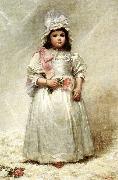 |
Elizabeth Lyman Boott Duveneck -- Click Here
|
|
1846-1888
Elizabeth Lyman Boott Duveneck Gallery |
|
 |
Eglon van der Neer -- Click Here
|
|
(1635/36, - May 3, 1703), was a Dutch painter of historical scenes, portraits and elegant, fashionable people, and later of landscapes.
Van der Neer was born in Amsterdam and was probably first taught by his father, Aert van der Neer, who married in Amsterdam in 1629, coming from Gorinchem. Eglon had a least five brothers and sisters, who were baptized in the Nieuwe Kerk between 1640 and 1650. He took lessons from Jacob van Loo, who was then one of the foremost figure painters in Amsterdam. Around 1654 Van der Neer, who probably had just finished his education with Van Loo, traveled to Orange, Vaucluse in the South of France and entered the service of Friedrich von Dohna (1621-1688), Governor of the Principality of Orange. Van der Neer stayed for three or four years in Orange and returned to Amsterdam by the end of 1658. There he married in February Maria Wagensvelt, the daughter of a wealthy Rotterdam notary. In 1663 Van der Neer and his family moved to Rotterdam, where Adriaen van der Werff became his student. He stayed in Rotterdam until his wife died in 1677. In 1679 he moved to The Hague and in 1680 he became a member of the Confrerie Pictura there. Later that year he moved again, taking up his residence at Brussels, where he married the miniature painter Marie Du Chastel in the following year. She bore him nine children.
|
|
 |
Egbert van der Poel -- Click Here
|
|
Egbert van der Poel (Delft, 1621 - Rotterdam, 1664) was a Dutch Golden Age genre and landscape painter, son of a Delft goldsmith.
He may possibly have been a student of Esaias van de Velde and of Aert van der Neer. According to the RKD he was the brother of the painter Adriaen Lievensz van der Poel and a student of Cornelis Saftleven in Rotterdam. Van der Poel was registered with the Guild of St Luke in Delft on October 17, 1650, where he is listed as a landscape painter. In 1651 van der Poel married Aeltgen Willems van Linschooten in Maassluis, near Rotterdam. His most famous paintings depict the Delft gunpowder explosion of October 12, 1654 and its aftermath; he and his wife were living in the area at the time. Egbert and Aeltgen van der Poel had a son and three daughters. He died in Rotterdam in 1664. |
|
|
|
|
|
 |
Eduardo de Martino -- Click Here
|
|
painted Combate naval in 1838 - 1912 |
|
 |
Edouard Louis Dubufe -- Click Here
|
|
Edouard Louis Dubufe (30 April 1820 - 11 August 1883) was a French painter.
He learned the art of painting from his father, Claude Marie Dubufe.
Until the 1840s, he painted primarily historical and biblical scenes, then switched to portrait painting. |
|
 |
edouard Joseph Dantan -- Click Here
|
|
painted Un Coin du Salon en 1880 |
|
 |
Edouard Detaille -- Click Here
|
|
(October 5, 1848 - December 23, 1912), was a French Academic painter and military artist noted for his precision and realistic detail.
Detaille was a student of Jean-Louis-Ernest Meissonier. He served in the French Army in the Franco-Prussian War of 1870-1871 and became the official painter of the battles. He is famous for his portraits of soldiers and depictions of military manoeuvres, military uniforms and general military life. |
|
 |
Edouard Debat Ponsan -- Click Here
|
|
French Academic Painter, 1847-1913
1847-1913.French painter. He trained in Toulouse and later at the Ecole des Beaux-Arts in Paris under Alexandre Cabanel. In 1873 he won second place in the Prix de Rome and in 1874 the Prix Troyon of the Institut. From the Institut he received a bursary that enabled him to visit Italy. In 1870 he made his debut at the Salon under the name Ponsan-Debat and afterwards exhibited there such genre and history paintings as Jephthah's Daughter (1876; Carcassonne, Mus. B.-A.). He also executed religious works, some of which were for churches and cathedrals: he painted St Paul before the Areopagus (1877) for the church at Courbevoie and the Pity of St Louis for the Dead (1879) for the cathedral at La Rochelle. From 1880 Debat-Ponsan was the name under which he exhibited. The Massage (1883; Toulouse, Mus. Augustins) shows a white female nude massaged by a negress, and the subject attracted comment from contemporary critics. He also painted a number of landscapes, including Corner of the Vineyard (1888; Nantes, Mus. B.-A.). These were painted in a style similar to that of Jules Bastien-Lepage and, when they included figures, were often sentimental. His reputation depended, however, on his portraits, which are distinguished by their vigorous colour and precision, as seen in the portrait of Pouyer-Quertier (c. 1885; Rouen, Mus. B.-A.). Most notable was his portrait of General Boulanger (1887; untraced), which was shown at the Salon of 1887 and was accepted in 1889 for the Exposition Universelle in Paris. Amid scandal, Debat-Ponsan withdrew it soon after the opening because he thought that the Exposition was badly organized and his painting was not shown to advantage. He refused the bronze medal awarded it by the jury. In later years, while producing such paintings as Christ on the Mountain (1889; Toulouse, Mus. Augustins), he increasingly responded to contemporary events in his work. |
|
|
|
Edouard Armand-Dumaresq -- Click Here
|
|
French, 1826-1895 |
|
|
|
 |
Edgar Degas -- Click Here
|
|
French Realist/Impressionist Painter and Sculptor, 1834-1917
French painter, draughtsman, printmaker, sculptor, pastellist, photographer and collector. He was a founder-member of the Impressionist group and the leader within it of the Realist tendency. He organized several of the group exhibitions, but after 1886 he showed his works very rarely and largely withdrew from the Parisian art world. As he was sufficiently wealthy, he was not constricted by the need to sell his work, and even his late pieces retain a vigour and a power to shock that is lacking in the contemporary productions of his Impressionist colleagues. |
|
 |
DYCK, Sir Anthony Van -- Click Here
|
|
Flemish Baroque Era Painter, 1599-1641
Flemish painter and draughtsman, active also in Italy and England. He was the leading Flemish painter after Rubens in the first half of the 17th century and in the 18th century was often considered no less than his match. A number of van Dyck's studies in oil of characterful heads were included in Rubens's estate inventory in 1640, where they were distinguished neither in quality nor in purpose from those stocked by the older master. Although frustrated as a designer of tapestry and, with an almost solitary exception, as a deviser of palatial decoration, van Dyck succeeded brilliantly as an etcher. He was also skilled at organizing reproductive engravers in Antwerp to publish his works, in particular The Iconography (c. 1632-44), comprising scores of contemporary etched and engraved portraits, eventually numbering 100, by which election he revived the Renaissance tradition of promoting images of uomini illustri. His fame as a portrait painter in the cities of the southern Netherlands, as well as in London, Genoa, Rome and Palermo, has never been outshone;
|
|
 |
Dyck, Anthony van -- Click Here
|
|
Flemish Baroque Era Painter, 1599-1641
Flemish painter and draughtsman, active also in Italy and England. He was the leading Flemish painter after Rubens in the first half of the 17th century and in the 18th century was often considered no less than his match. A number of van Dyck's studies in oil of characterful heads were included in Rubens's estate inventory in 1640, where they were distinguished neither in quality nor in purpose from those stocked by the older master. Although frustrated as a designer of tapestry and, with an almost solitary exception, as a deviser of palatial decoration, van Dyck succeeded brilliantly as an etcher. He was also skilled at organizing reproductive engravers in Antwerp to publish his works, in particular The Iconography (c. 1632-44), comprising scores of contemporary etched and engraved portraits, eventually numbering 100, by which election he revived the Renaissance tradition of promoting images of uomini illustri. His fame as a portrait painter in the cities of the southern Netherlands, as well as in London, Genoa, Rome and Palermo, has never been outshone; and from at least the early 18th century his full-length portraits were especially prized in Genoese, British and Flemish houses, |
|
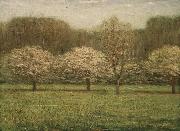 |
Dwight William Tryon -- Click Here
|
|
(August 13, 1849 ?C July 1, 1925) was an American landscape painter in the late 19th and early 20th centuries. His work was influenced by James McNeill Whistler, and he is best-known for his landscapes and seascapes painted in a tonalist style.
Tryon was born in Hartford, Connecticut. His father was killed in a gun accident before Tryon reached four years of age, and Tryon was raised by his mother on his grandparent's farm in East Hartford. His interest in art evolved naturally. As a young man Tryon took a job at a prominent Hartford bookstore and studied art instruction manuals from the store shelves. He also took to sketching the surrounding countryside during his off hours
Tryon sold his first painting in 1870. After exhibiting and selling work locally, he successfully exhibited at the National Academy of Design in 1873. His artistic convictions affirmed, Tryon married, quit his job at the bookstore and became a full-time artist. Some of his first works from this period are seascapes and harbor views executed in a luminist manner. Soon after, however, Tryon's style shifted towards the Barbizon school, which was then becoming popular among American artists. He may have been influenced by the works of George Inness and Alexander Helwig Wyant.
In 1876 Tryon decided to advance his skills through a formal study of art. He sold all of his paintings at auction and, with the help of a benefactor, traveled to France with his wife. He enrolled in the atelier of Jacquesson de la Chevreuse, and took classes at the École des Beaux-Arts. He also received instruction from Charles-François Daubigny, Henri Harpignies, and Jean Baptiste-Antoine Guillemet. Impressionism was blossoming in France all around Tryon, but he was not swayed by the new style and remained comfortably within the realm of the Barbizon school.
Tryon traveled and sketched Europe with his wife, and met Abbott Handerson Thayer and his wife with whom he became friends. He returned to the United States in 1881 and settled in New York City where he taught and painted landscapes. In New York, Tryon became friends with artists Robert Swain Gifford and Thomas Dewing. He became an early member of the Society of American Artists and continued to exhibit paintings to the National Academy of Design. He also became a member of the American Water Color Society and the National Institute of Arts and Letters (now The American Academy of Arts and Letters).
On the advice of Gifford, Tryon and his wife built a summer house in South Dartmouth, Massachusetts in 1887. Though he would continue to spend each winter in New York City, South Dartmouth became Tryon's home for the rest of his life. The coastal area appealed to Tryon's aesthetic sensibilities and allowed him to indulge in fishing, his favorite pastime.
By the late 1880s Tryon began painting landscapes in what would become his mature and iconic style. Working most often in oil, Tryon's paintings typically feature a group or broken row of trees in the middle distance, often colored in an autumnal hue, separating a glowing sky above and a foreground marsh or pasture below. He also continued to paint the sea in his mature career, often employing pastel to show a bare expanse of water, sky and beach in various weather and light. He exhibited his works nationally but tended to favor The Pennsylvania Academy of Fine Arts in Philadelphia and the Montross Gallery in New York.
A Detroit industrialist, Charles Lang Freer, first bought a painting by Tryon in 1889 and became Tryon's most important patron. Freer eventually bought dozens of Tryon's paintings, including many of his best works, and worked closely with Tryon in the interior design of his Detroit home. Freer, a major collector of Asian art and works by James McNeill Whistler, went on to establish the Freer Gallery of Art, part of the Smithsonian Institution in Washington, DC, where many works by Tryon can be seen today.
Took the coveted First Prize for his painting Salt-Marsh, December at the Tennessee Centennial Exposition that was held in Nashville, Tennessee in 1897. He is described in the "Fine Art Catalogue" which is copyrighted by Theodore Cooley as follows: William Tryon is an American landscape painter whose pictures are greatly sought for their delicacy of coloring and refinement of feeling. A pupil of Daubdigny, he is, like that artist, a painter of country life - the idyllic rusticity of apple trees in bloom, of waving cornfields, of shining valleys and streams rippling gently to the sea. He is especially fine in the silvery-gray atmosphere.
In addition to his painting, Tryon taught at Smith College from 1886 to 1923, visiting part time to critique students' work and, late in his career, establishing the Tryon Gallery of Art. He died of cancer in South Dartmouth on July 1, 1925.
|
|
|
|
 |
DUYSTER, Willem Cornelisz. -- Click Here
|
|
Dutch Baroque Era Painter, 1599-1678 |
|
 |
DUVIVIER, Jan Bernard -- Click Here
|
|
b. 1762, Bruges, d. 1837, Paris |
|
 |
Dutilleux Constant -- Click Here
|
|
French , 1807-Arras 1865
|
|
 |
DUSART, Cornelis -- Click Here
|
|
Dutch Baroque Era Painter, 1660-1704
Dutch painter, draughtsman and printmaker. He was the son of the organist at St Bavo in Haarlem and one of the last pupils of Adriaen van Ostade. He became a member of the Haarlem Guild of St Luke on 10 January 1679 and served as its dean in 1692. Dated pictures by Dusart have survived from almost every year between 1679 and 1702. Two of his earliest pictures of peasants relied heavily on compositions by van Ostade: Mother and Child (1679; Dresden, Gemeldegal. Alte Meister) and Woman Selling Milk (1679; sold Amsterdam, Muller, 16 Oct 1928, lot 9; the original drawing by van Ostade is in Paris |
|
 |
Durrie George Henry -- Click Here
|
|
American Painter
b.1820 d.1863
Durrie and his older brother John (1818-98) studied sporadically from 1839 to 1841 with the portrait painter Nathaniel Jocelyn. From 1840 to 1842 he was an itinerant painter in Connecticut and New Jersey, finally settling permanently in New Haven. He produced c. 300 paintings, of which the earliest were portraits (e.g. Self-portrait, 1839; Shelburne, VT, Mus.); by the early 1850s he had begun to paint the rural genre scenes and winter landscapes of New England that are considered his finest achievement. His landscapes, for example A Christmas Party (1852; Tulsa, OK, Gilcrease Inst. Amer. Hist. & A.), are characterized by the use of pale though cheerful colours and by the repeated use of certain motifs: an isolated farmhouse, a road placed diagonally leading the eye into the composition, and a hill (usually the West or East Rocks, New Haven) in the distance. By the late 1850s Durrie's reputation had started to grow, and he was exhibiting at prestigious institutions, such as the National Academy of Design. In 1861 the firm of Currier & Ives helped popularize his work by publishing prints of two of his winter landscapes, New England Winter Scene (1858; Mr and Mrs Peter Frelinghuysen Carleton priv. col.) and the Farmyard in Winter. |
|
 |
DUPUYS, Pierre -- Click Here
|
|
French painter (b. 1610, Montfort l'Amaury, d. 1682, Paris).
|
|
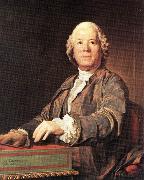 |
DUPLESSIS, Joseph Siffrein -- Click Here
|
|
French Painter, 1725-1802 |
|
 |
DUMOUSTIER, Pierre -- Click Here
|
|
French painter (c. 1540 - after 1600) |
|
 |
DUJARDIN, Karel -- Click Here
|
|
Dutch Baroque Era Painter, ca.1622-1678
Dutch painter and etcher. He studied with Berchem and in Italy. Dujardin was particularly successful in painting landscapes with figures and animals, and he made some 51 fine etchings of similar subjects. |
|
 |
DUGHET, Gaspard -- Click Here
|
|
French Baroque Era Painter, 1615-1675
Italian painter. He was one of the most distinguished landscape painters working in Rome in the 17th century, painting decorative frescoes and many easel paintings for such major Roman patrons as Pope Innocent X and the Colonna family. He is associated with a new genre of landscape, the storm scene, although of some 400 catalogued works little more than 30 treat this theme. His most characteristic works depict the beauty of the scenery around Rome, particularly near Tivoli, and suggest the shifting patterns of light and shade across a rugged terrain. Dughet drew from nature, yet his landscapes are carefully structured, and figures in antique dress suggest the ancient beauty of a landscape celebrated by Virgil. Very few can be securely dated; his development may be inferred from his few dated fresco paintings and from the wider context in which he was working. Most writers, following Pascoli, have divided Dughet's career into three periods. |
|
 |
DUCK, Jacob -- Click Here
|
|
Dutch painter (b. ca. 1600, Utrecht, d. after 1660, Utrecht) |
|
 |
Duccio di Buoninsegna -- Click Here
|
|
1255-1318
Italian Duccio di Buoninsegna Locations
Italian painter. He was one of the most important painters of the 14th century and like his slightly younger contemporary, Giotto, was a major influence on the course of Italian painting. An innovator, he introduced into Sienese painting new altarpiece designs, a dramatic use of landscape, expressive emotional relationships, extremely complex spatial structures and a subtle interplay of colour. His most important and revolutionary work, the Maeste for Siena Cathedral, was never matched during the 14th century, if at all, and his influence lasted well into the 15th century. |
|
 |
Duccio -- Click Here
|
|
1255-c1319
Italian
Duccio Location
Italian painter. He was one of the most important painters of the 14th century and like his slightly younger contemporary, Giotto, was a major influence on the course of Italian painting. An innovator, he introduced into Sienese painting new altarpiece designs, a dramatic use of landscape, expressive emotional relationships, extremely complex spatial structures and a subtle interplay of colour. His most important and revolutionary work, the Maeste for Siena Cathedral, was never matched during the 14th century, if at all, and his influence lasted well into the 15th century. |
|
 |
DROST, Willem -- Click Here
|
|
Dutch Baroque Era Painter, ca.1630-1680
Dutch painter, draughtsman and printmaker, possibly of German origin. According to Houbraken, he was a pupil of Rembrandt, possibly in or shortly before 1650. An early etching signed w drost 1652 is probably a self-portrait, in which Drost portrayed himself as a young man drawing. His earliest dated paintings are two pendants of 1653: the Portrait of a Man (New York, Met.) and the Portrait of a Woman (The Hague, Mus. Bredius). The man's portrait is signed Wilhelmus Drost F. Amsterdam 1653 |
|
 |
Douglas Volk -- Click Here
|
|
1856-1935
Douglas Volk (1856 - 1935) was an American portrait painter and the son of noted sculptor Leonard Volk. He was named after his mother's cousin (Abraham Lincoln's political rival) Stephen A. Douglas. |
|
|
|
 |
Douglas Cowper -- Click Here
|
|
painted William Powell Frith in 1836-1838
|
|
 |
DOU, Gerrit -- Click Here
|
|
Dutch Baroque Era Painter, 1613-1675
Dutch painter. The first and most famous member of the group of artists referred to as the LEIDEN 'FINE' PAINTERS, he specialized in small-format paintings, the details and surfaces of which are carefully observed and meticulously rendered. He was greatly praised as a painter of artificial light by Samuel van Hoogstraten in 1678, and he was responsible for popularizing both the night scene and the 'niche' format, pictorial devices ultimately derived from the art of his famous master, Rembrandt.
|
|
 |
Dosso Dossi -- Click Here
|
|
1479-1542
Italian
Dosso Dossi Locations
Italian painter of the Ferrarese school, whose real name was Giovanni di Niccolo de Luteri. He may have been a pupil of Lorenzo Costa, but was certainly influenced by Giorgione, Titian, and Raphael. He often collaborated with his brother Battista, a landscape painter. Dosso Dossi is first recorded in Mantua, but after 1514 he executed many decorative works for the ducal palace and churches of Ferrara, including frescoes, pictures, and cartoons for tapestries. Both his landscapes and portraits show originality and imagination. He was a friend of Ariosto, who mentions him in Orlando Furioso. His works include Circe in the Woods (Borghese Villa); The Three Ages of Man (Metropolitan Mus.); The Standard Bearer, Scene from a Legend, and Saint Lucretia (National Gall. of Art, Washington, D.C.). |
|
 |
DOSSI, Dosso -- Click Here
|
|
Italian High Renaissance Painter, ca.1490-1542
Although responsive to a wide range of outside influences, the most important of which were probably those of Giorgione in Venice and Raphael in Rome, he was an artist of great originality with a strong feeling for effects of light and colour. Landscape plays a prominent and highly expressive role in his work. He was employed, as were also the poets Matteomaria Boiardo (?1441-94) and Ludovico Ariosto, at the court of Ferrara, which was internationally renowned for its culture, especially its musical life and collections of art: one of his best-known works is an illustration of a magical scene from Ariosto's poetry, |
|
|
|
 |
Dorfmeister, Istvan -- Click Here
|
|
Hungarian Painter, ca.1729-1797 |
|
 |
Dora Carrington -- Click Here
|
|
British Painter,
1893-1932
English painter and decorative artist. Daughter of a Liverpool merchant, she was brought up in Bedford. She trained at the Slade School of Fine Art in London where she met John Nash, who aroused her interest in wood-engraving, and Mark Gertler, whose powerful figure paintings influenced her own approach to portraiture. She rejected Gertler as a lover and set up home with the homosexual essayist and biographer Lytton Strachey (1880-1932), first at Tidmarsh Mill, near Pangbourne, Berks, then at Ham Spray, between Newbury and Hungerford, Berks. In 1921 she married Ralph Partridge, living with him and Strachey in a m?nage ? trois, surrounded mainly by literary friends and receiving little encouragement to exhibit. She turned instead to decorative work, emulating Vanessa Bell and Duncan Grant but in a style more native in inspiration and more naive. She designed tiles and inn signs, experimented with painting on glass and tinfoil, decorated furniture and designed the library at Ham Spray. |
|
 |
Donato Creti -- Click Here
|
|
(1671-1749) was an Italian painter of the Rococo period, active mostly in Bologna.
Born in Cremona, he moved to Bologna, where he was a pupil of Lorenzo Pasinelli. He is described by Wittkower as the "Bolognese Marco Benefial", in that his style was less decorative and edged into a more formal neoclassical style. It is an academicized grand style, that crystallizes into a manneristic neoclassicism, with crisp and frigid modeling of the figures. Among his followers were Aureliano Milani, Francesco Monti, and Ercole Graziani the Younger. Two other pupils were Domenico Maria Fratta and Giuseppe Peroni |
|
 |
Donatien Nonotte -- Click Here
|
|
France (1708 -1785 ) - Painter
|
|
 |
Donatello -- Click Here
|
|
Italian Early Renaissance Sculptor, 1386-1466,Italian sculptor. He was the most imaginative and versatile Florentine sculptor of the early Renaissance, famous for his rendering of human character and for his dramatic narratives. He achieved these ends by studying ancient Roman sculpture and amalgamating its ideas with an acute and sympathetic observation of everyday life. Together with Alberti, Brunelleschi, Masaccio and Uccello, Donatello created the Italian Renaissance style, which he introduced to Rome, Siena and Padua at various stages of his career. He was long-lived and prolific: between 1401 and 1461 there are 400 documentary references to him, some for nearly every year. |
|
 |
Donat, Johann Daniel -- Click Here
|
|
painted Emperor Leopold II in the regalia of the in 1806 |
|
 |
Dominique Vivant Denon -- Click Here
|
|
French, 1747-1825,French savant, he accompanied the Napoleonic expedition to Egypt (1798) as leader of the learned Commission on the Sciences and Arts that was to study Ancient Egyptian buildings and architecture and herald the birth of modern Egyptology. In 1802 he published his Voyage dans la Basse et la Haute Egypte pendant les campagnes du general Bonaparte (Journey in Lower and Upper Egypt during the campaigns of General Bonaparte). An accurate source-book of Ancient Egyptian architecture, it had an extraordinary impact, triggering the C19 Egyptian Revival that at first was correctly described as Egyptomania, and was a major influence on Neo-Classicism. Denon was Director-General of Museums, and was in charge of the Musee Napoleon (now the Louvre). |
|
 |
Dominic Serres -- Click Here
|
|
British Painter, 1722-1793 |
|
 |
Domingos Sequeira -- Click Here
|
|
Domingos Sequeira (1768-1837). |
|
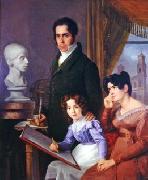 |
Domingos Antonio de Sequeira -- Click Here
|
|
painted Familia Barros in19th century
|
|
 |
Domingo Garcia y Vasquez -- Click Here
|
|
painted Ponta do Cavalao - Niteroi in 1883 |
|
 |
Domenico Zampieri -- Click Here
|
|
(October 21, 1581 C April 16, 1641) was an Italian Baroque painter of the Bolognese School, or Carracci School, of painters.
Domenichino was born at Bologna, son of a shoemaker, and there initially studied under Denis Calvaert. After quarreling with Calvaert, he left to work in the Accademia degli Incamminati of the Carracci where, because of his small stature, he was nicknamed Domenichino, meaning "little Domenico" in Italian. He left Bologna for Rome in 1602 and became one of the most talented apprentices to emerge from Annibale Carracci's supervision. As a young artist in Rome he lived with his slightly older Bolognese colleagues Albani and Guido Reni, and worked alongside Lanfranco, who later would become a chief rival.
In addition to assisting Annibale with completion of his frescoes in the Galleria Farnese, including A Virgin with a Unicorn (c. 1604-5), he painted three of his own frescoes in the Loggia del Giardino of the Palazzo Farnese c. 1603-04. With the support of Monsignor Giovanni Battista Agucchi, the maggiordomo to Cardinal Aldobrandini and later Gregory XV, and Giovanni??s brother Cardinal Girolamo Agucchi, Domenichino obtained further commissions in Rome. His most important project of the first decade was decoration of the Cappella dei Santissimi Fondatori in the medieval basilica of the Abbey of Grottaferrata (1608-10), some 20 kilometers outside Rome, where Odoardo Farnese was the titular abbot. Meanwhile he had completed frescoes c. 1604-05 in the church of Sant'Onofrio, feigned stucco decoration of 1606-07 in the Palazzo Mattei, a large scene of The Flagellation of St. Andrew at San Gregorio Magno, painted in competition with a fresco by Reni that faces it, and a ceiling with Scenes from the Life of Diana, 1609, in the Villa Odescalchi at Bassano di Sutri (today Bassano Romano).
Following Annibale Carracci's death in 1609, Annibale's Bolognese pupils, foremost Domenichino, Albani, Reni and Lanfranco, became the leading painters in Rome (Caravaggio had left Rome in 1606 and his followers there did not compete successfully with the Bolognese for fresco or altarpiece commissions). One of Domenichino's masterpieces, his frescoes of Scenes of the Life of Saint Cecilia in the Polet Chapel of San Luigi dei Francesi, was commissioned in 1612 and completed in 1615. Concurrently he painted his first, and most celebrated, altarpiece, The Last Communion of St. Jerome for the church of San Girolamo della Carite (signed and dated, 1614). It subsequently would be judged as being comparable to Raphael great Transfiguration and even as "the best picture in the world."
By late 1616, Domenichino had designed the coffered ceiling with The Assumption of the Virgin in Santa Maria in Trastevere; and he had begun a cycle of ten frescoes depicting the Life of Apollo in a garden pavilion of the Villa Aldobrandini (Belvedere) in Frascati, where he was assisted by Giovanni Battista Viola, a Bolognese artist who, like Domenichino himself, was a pioneer in the development of classicistic landscape painting. From 1617 until 1621, Domenichino was absent from Rome, working in Bologna and at Fano, where during 1618-19 he frescoed the Nolfi chapel of the Fano Cathedral with Scenes from the Life of the Virgin.
With the election of a Bolognese pope (Gregory XV) in 1621, Domenichino returned to Rome. Appointed Papal Architect (he built little but left drawings for various projects, most notably for the façade of Sant'Andrea della Valle and for the plan of Sant'Ignazio, both in Rome), he nonetheless continued to be most active as a painter, obtaining many commissions for altarpieces in Roman churches (San Lorenzo in Miranda, 1626-27, SS. Giovanni Evangelista e Petronio dei Bolognese, 1626-29, Santa Maria della Vittoria, 1629-30, and St. Peter's, 1625-30). He also executed numerous frescoes in Rome during the 1620s: a ceiling in the Palazzo Costaguti (c. 1622); the choir and pendentives in Sant'Andrea della Valle, where he worked in fierce competition with Lanfranco, who painted the dome above Domenichino's pendentives; and the pendentives of San Silvestro al Quirinale (c. 1628) and San Carlo ai Catinari (1628-30). |
|
 |
DOMENICO VENEZIANO -- Click Here
|
|
Italian Early Renaissance Painter, ca.1400-1461
|
|
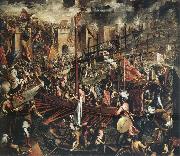 |
Domenico Tintoretto -- Click Here
|
|
Italian, 1560-1635,Son of Jacopo Tintoretto. He was taught by his father and assisted him in his workshop. At the age of 17 he was admitted to the Venetian painters' guild, and he is recorded in the confraternity of painters from 1594. He began his career by helping his father to execute the paintings in the Sala del Collegio and Sala del Senato in the Doge's Palace, Venice. Following this he worked independently at the palace, on the Sala dello Scrutinio and the Sala del Maggiore Consiglio. His training with his father helped him in his own compositions, several of which, such as the Battle of Salvore, or the Second Conquest of Constantinople, are heroic battle themes with complex groupings and dramatic poses. In the last two decades of the 16th century Domenico concentrated on religious commissions in Venice, including a Last Supper and Crucifixion (both c. 1583) for S Andrea della Zirada (both in situ), a Marriage of the Virgin for S Giorgio Maggiore (in situ) and a Crucifixion for the Scuola dei Mercanti. |
|
 |
Domenico Quaglio -- Click Here
|
|
(1787-1837) was a German painter, engraver, stage designer, and architect. He was the second son of Giuseppe Quaglio and part of the large Quaglio pedigree of Italian artists involved in architecture, indoor fresco decoration, and scenography for the court theaters. He known as a landscape and architectural painter/decorator, including quadratura. He was born in Munich. He was taught perspective and scene-painting by his father, and engraving by Mettenleiter and Karl Hess. In 1819 he resigned his post as scene-painter, and occupied himself only with architecture, for which he obtained subjects in the Netherlands, Italy, France, and England. As architect in charge, Domenico Quaglio was responsible for the neogothic style of the exterior design of Hohenschwangau Castle, summer and hunting residence of King Maximilian II of Bavaria, son of King Ludwig I of Bavaria and father of King Ludwig II. Quaglio died at Hohenschwangau in 1837. |
|
 |
Domenico Puligo -- Click Here
|
|
(1492-1527) was an Italian painter of the Renaissance, active in Florence. His real name was Domenico di Bartolommeo Ubaldini.
He was trained by Ridolfo Ghirlandaio, but acquired a style consistent with his contemporary Andrea del Sarto. He painted a Vision of Saint Bernard altarpiece, now in Walters' Gallery in Baltimore. He was also in demand for portraits. He is featured in Giorgio Vasari's Vite or biographies of artists. He excelled as a portrait painter. He befriended Andrea del Sarto ane worked with Ridolfo Ghirlandaio. His brother, Jacone Puligo was also a Renaissance painter.
|
|
 |
Domenico Morelli -- Click Here
|
|
Italian, 1826-1901,Italian painter and teacher. Unique among his Italian colleagues in enjoying an international reputation in his lifetime, he was, with Filippo Palizzi (see PALIZZI, (2)), the leading exponent of the Neapolitan school of painting in the second half of the 19th century and a major figure in the artistic and cultural life of Italy. His realistic treatment of Romantic subjects revitalized academic painting, |
|
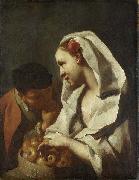 |
Domenico Maggiotto -- Click Here
|
|
painted The Fruit Girl in 1745 - 1770
|
|
 |
Domenico Induno -- Click Here
|
|
(1815 - 1878) was an Italian painter, originally a goldsmith.
He was born and died in Milan, and studied in the Academy of Fine Arts in Milan, as well as under Luigi Sabatelli and at Rome. He tried successively the Neoclassicism and Romantic schools, but afterwards settled down to depict popular life at Milan. In 1848 he took part with the Revolution, and had in consequence to flee to Switzerland. Thence he passed to Tuscany, and did not return home until 1859. His brother Gerolamo Induno was also a painter. Domenico married the sister of the Swiss painter Angelo Trezzini. Domenico often painted patriotic canvases, in a style indebted both to Ingres and Francesco Hayez. Among his paintings are:
|
|
 |
Domenico Ghirlandaio -- Click Here
|
|
Italian
1449-1494
Domenico Ghirlandaio Galleries
Painter, mosaicist and possibly goldsmith. He was head of one of the most active workshops in late 15th-century Florence. He developed a style of religious narrative that blended the contemporary with the historical in a way that updated the basic tenets of early Renaissance art. Domenico documented material situation |
|
 |
Domenico Fetti -- Click Here
|
|
Italian painter ,
Rome 1589 - Venice 1623
was an Italian Baroque painter active mainly in Rome, Mantua and Venice. Born in Rome to a little-known painter, Pietro Fetti, Domenico is said to have apprenticed initially under Ludovico Cigoli, or his pupil Andrea Commodi in Rome from circa 1604-1613. He then worked in Mantua from 1613 to 1622, patronized by the Cardinal, later Duke Ferdinando I Gonzaga. In the Ducal Palace, he painted the Miracle of the Loaves and Fishes. The series of representations of New Testament parables he carried out for his patron's studiolo gave rise to a popular specialty, and he and his studio often repeated his compositions. In August or September 1622, his feuds with some prominent Mantuans led him to move to Venice, which for the first few decades of the seventeenth century had persisted in sponsoring Mannerist styles (epitomized by Palma the Younger and the successors of Tintoretto and Veronese). Into this mix, in the 1620s?C30s, three "foreigners"??Fetti and his younger contemporaries Bernardo Strozzi and Jan Lys??breathed the first influences of Roman Baroque style. They adapted some of the rich coloration of Venice but adapted it to Caravaggio-influenced realism and monumentality. In Venice where he remained despite pleas from the Duke to return to Mantua, Fetti changed his style: his formalised painting style became more painterly and colourful. |
|
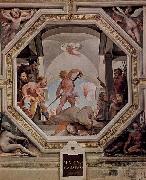 |
Domenico di Pace Beccafumi -- Click Here
|
|
(1486?CMay 18, 1551) was an Italian Renaissance-Mannerist painter active predominantly in Siena. He is considered one of the last undiluted representatives of the Sienese school of painting.
Domenico was born in Montaperti, near Siena, the son of Giacomo di Pace, a peasant who worked on the estate of Lorenzo Beccafumi. Seeing his talent for drawing, Lorenzo adopted him, and commended him to learn painting from Mechero, a lesser Sienese artist. In 1509 he traveled to Rome, but soon returned to Siena, and while the Roman forays of two Sienese artists of roughly his generation (Il Sodoma and Peruzzi) had imbued them with elements of the Umbrian-Florentine Classical style, Beccafumi's style remains, in striking ways, provincial. In Siena, he painted religious pieces for churches and of mythological decorations for private patrons, only mildly influenced by the gestured Mannerist trends dominating the neighboring Florentine school. |
|
 |
DOMENICO DI MICHELINO -- Click Here
|
|
Italian painter, Florentine school (b. 1417, Firenze, d. 1491, Firenze)
Italian painter. He took his name from his teacher, a carver in bone and ivory named Michelino. He was elected to the Compagnia di S Luca in 1442 and joined the Arte dei Medici e degli Speziali on 26 October 1444. In 1459 he received payment from Lorenzo Pucci for a processional banner (untraced) for a confraternity based in S Francesco, Cortona. Four years later he was paid for some figures of saints (untraced) for a cupboard belonging to the Compagnia di S Maria della Purificazione e di S Zanobi,
|
|
 |
DOMENICO DI BARTOLO -- Click Here
|
|
Italian Early Renaissance Painter, 1400-ca.1447
was an Italian painter of the Sienese School. He was born in Asciano. According to Vasari, he was a nephew of Taddeo di Bartolo. He was employed by Vecchietta in the masterpiece fresco The Care of the Sick in the Pellegrinaio (Pilgrim's Hall) of the Ospedale di Santa Maria della Scala in Siena[1]. It portrays wealthy donors visiting the hospital to men washing the ill, and a fatty friar hearing confession. In 1434, |
|
 |
DOMENICO DA TOLMEZZO -- Click Here
|
|
Italian painter, Venetian school (b. ca. 1448, Friuli, d. 1507, Friuli)
|
|
 |
domenico chirlandaio -- Click Here
|
|
Domenico Ghirlandaio (1449 - 11 January 1494) was an Italian Renaissance painter from Florence. Among his many apprentices was Michelangelo.
Ghirlandaio's full name is given as Domenico di Tommaso di Currado di Doffo Bigordi. The occupation of his father Tommaso Bigordi and his uncle Antonio in 1451 was given as 'setaiuolo a minuto,' that is, dealers of silks and related objects in small quantities. He was the eldest of six children born to Tommaso Bigordi by his first wife Mona Antonia; of these, only Domenico and his brothers and collaborators Davide and Benedetto survived childhood. Tommaso had two more children by his second wife, also named Antonia, whom he married in 1464. Domenico's half-sister Alessandra (b. 1475) married the painter Bastiano Mainardi in 1494.
Domenico was at first apprenticed to a jeweller or a goldsmith, most likely his own father. The nickname Il Ghirlandaio (garland-maker) came to Domenico from his father, a goldsmith who was famed for creating the metallic garland-like necklaces worn by Florentine women. In his father's shop, Domenico is said to have made portraits of the passers-by, and he was eventually apprenticed to Alessio Baldovinetti to study painting and mosaic. |
|
 |
Domenico Brusasorci -- Click Here
|
|
Italian High Renaissance Painter , Verona 1515 ca. - 1567 |
|
 |
Domenico Beccafumi -- Click Here
|
|
c1486-1551
Domenico Beccafumi Gallery
Italian painter, sculptor, draughtsman, printmaker and illuminator. He was one of the protagonists, perhaps even the most precocious, of Tuscan Mannerism, which he practised with a strong sense of his Sienese artistic background but at the same time with an awareness of contemporary developments in Florence and Rome. He responded to the new demand for feeling and fantasy while retaining the formal language of the early 16th century. None of Beccafumis works is signed or dated, but his highly personal maniera has facilitated almost unanimous agreement regarding the definition of his corpus and the principal areas of influence on it. However, some questions concerning the circumstances of his early career and the choices available to him remain unanswered. The more extreme forms of Beccafumis reckless experimentation underwent a critical reappraisal only in the later 20th century. |
|
 |
Domenico Feti -- Click Here
|
|
1589-1625
Italian
Domenico Feti Locations
Italian painter. Court painter to the Gonzaga family in Mantua, Feti was influenced by the chiaroscuro technique of Caravaggio. His later works, such as Melancholia (Louvre), belong, in their use of color, to the Venetian tradition. |
|
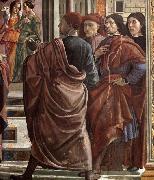 |
Domenicho Ghirlandaio -- Click Here
|
|
Renaissance Artists , 1449-94 |
|
 |
Domenichino -- Click Here
|
|
1581-1641
Italian
Domenichino Locations
Italian painter and draughtsman. On the basis of his frescoes and altarpieces he became established as the most influential exponent of the 17th-century classical style. Through his critical analysis of the art of Raphael and Annibale Carracci he was influential in the creation of a modern canon of the ancients; and he was perhaps the most complete example of a 17th-century artist struggling to reconcile tradition with the demand for spectacle. |
|
 |
Domenica Battaglia -- Click Here
|
|
painted La Fontana delle Paperelle, Napoli, in
1842/46-1904 |
|
 |
DOLCI, Carlo -- Click Here
|
|
Italian Baroque Era Painter, 1616-ca.1686
was an Italian painter of the Baroque period, active mainly in Florence, known for highly finished religious pictures, often repeated in many versions. He was born in Florence, on his mother's side the grandson of a painter. Although he was precocious and apprenticed at a young age to Jacopo Vignali, Dolci was not prolific. "He would take weeks over a single foot", according to his biographer Baldinucci.His painstaking technique made him unsuited for large-scale fresco painting. He painted chiefly sacred subjects, and his works are generally small in scale, although he made a few life-size pictures. He often repeated the same composition in several versions, and his daughter, Agnese Dolci, also made excellent copies of his works. Dolci was known for his piety. It is said that every year during Passion Week he painted a half-figure of the Saviour wearing the Crown of Thorns. In 1682, when he saw Giordano, |
|
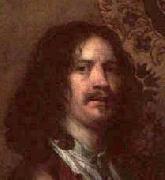 |
DOBSON, William -- Click Here
|
|
English Baroque Era Painter, ca.1611-1646
English painter. His father, William Dobson, was a gentleman of St Albans employed by Francis Bacon, Viscount Verulam, on the building and decoration at Verulam House and Gorhambury; he was also probably Master of the Alienation Office and a member of the Painter-Stainers' Company, but according to John Aubrey, 'he spending his estate luxuriously upon women, necessity forced his son William Dobson to be the most excellent painter |
|
 |
Dmitry Levitzky -- Click Here
|
|
1735-1822) was a Russian-Ukrainian portrait painter.
Dmitry was born in Kiev, Ukraine, in a family of clergyman and engraver Grigory Levitzky. His father was his first art teacher. Later be became a pupil of Aleksey Antropov who came to Kiev to paint the Cathedral of St. Andrew.
In 1770, Levitzky became famous as a portrait painter after the exhibition of six of his portraits in the Imperial Academy of Arts in St. Petersburg. For the portrait of Alexander Kokorinov, Director and First Rector of the Academy of Arts in St. Petersburg (1769) he was elected an academician and appointed the Professor of the portrait painting class at the Academy of Arts. |
|
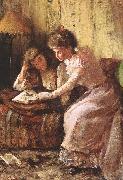 |
Dixon, Maria -- Click Here
|
|
American Painter, 19th Century |
|
|